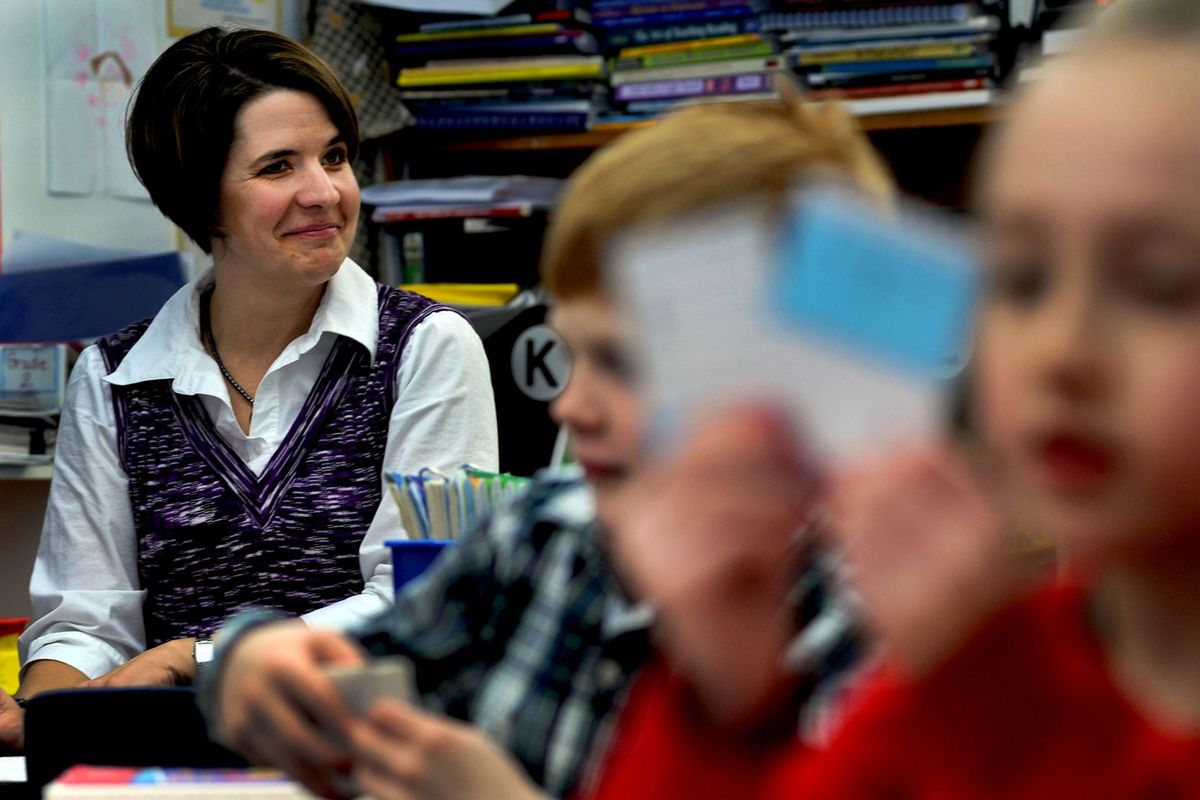Shared classrooms: Tight budgets may force more schools to combine grades

First-grader Bobby Best worked independently in the rural North Idaho classroom, diligently making her way through an activity book.
A short distance away, teacher Sara Butler instructed a reading group in Priest Lake Elementary’s K-2 class. Other students sat at their desks and read to each other or went across the hall to help kindergartners with spelling.
Priest Lake Elementary is the only school in the West Bonner School District with combined grade-level classrooms. In addition to K-2, grades 3-4 and 5-6 are combined classes.
Mixing primary grades is unusual in Inland Northwest school districts – Coeur d’Alene School District doesn’t have any such classes, and Spokane Public Schools has 35 mixed classes in its 34 elementary schools.
Teaching multiple curriculums is complicated, school officials say. Nevertheless, combined classes could become more commonplace as Washington and Idaho lawmakers cut further into education funding and school administrators look for ways to make more reductions.
“Priest Lake Elementary has combo classrooms due mainly to their small student population (47),” said Michael McGuire, superintendent of the West Bonner district. Plus, “combo classrooms are the only feasible way to organize learning for K-6 with only three regular education teachers.”
If legislation proposing further cuts to education is approved in Idaho, “we will be looking for any possibilities of combo classes for next fall at our other two elementary schools,” he said.
‘It’s run like a business here’
Teaching a combined-grade level class requires organization and multitasking.
Butler has to plan and teach three math curriculums, three reading curriculums and three writing curriculums. She makes it look easy, but she’s taught at the rural elementary school – tucked into the base of the Selkirk Mountains – for 12 years, she says.
“The planning and organizing is the biggest part,” Butler said. “If you were to look at my lesson plan book, it’s all separated,” pointing to her planner. Her school day is divided into 30-minute increments.
State assessments are another challenge. “Three different skills are tested three times per year for each grade,” Butler said. “I need to make sure I am aware of where they each need to be.”
Math ability among Butler’s students ranges from recognizing numbers and shapes to addition and subtraction. In writing, it’s recognizing a word to writing a book report. In reading, it ranges from identifying letters to reading chapter books.
To make it all work, Butler has a daily routine.
“In the morning, I have everything ready to go,” with worksheets on desks, for example. “The kids are good about looking at the board and getting started on what they need to do.”
She added, “It’s run like a business here. Everything needs to be perfectly ready.”
Butler has a teaching assistant and the help of volunteers, she said. The Priest Lake community raised money to pay for the assistant this school year because the district lacked funds.
The kids are also helpful. “While I’m teaching a math group, I’ve taught my kids to do a review from the day before or a math game,” Butler said.
Second-grader Hannah Palfry says she often helps the kindergartners and first-graders with math. “I teach them how to add. I like to help,” the 7-year-old said. “It gets them ready for the second grade.”
Mixing boosts social skills
In Canada, where about 21 percent of elementary classrooms are combined, a 2007 study by the education department in Ontario found the mixed grade levels help with students’ social development.
Students “learn how to work on their own and as part of a team, build leadership abilities as they work together and help each other and develop decision making skills, and become more self-motivated and responsible,” the study concluded.
The most recent study in the United States – 1991 – concurred with the benefit to students. “Observed work habits of children indicated a high degree of self discipline.”
The U.S. study noted that mixed classrooms are more common in rural districts for financial reasons. But larger school districts, like Spokane Public Schools, could be forced to increase the number of mixed-level classes.
Gone are the days when a teacher will have a small, one-grade class, said Staci Vesneske, assistant superintendent.
“Creation of them might be more common in the future because districts don’t have the flexibility financially of having a class of 18 or 19,” she said. “If you say every teacher has to be at 25, and there are two smaller classes at different grade levels, then you will end up with a combined class.”
The Coeur d’Alene School District has not taught combined classes for at least 10 years and doesn’t anticipate going back, but nothing is being ruled out, said spokeswoman Laura Rumpler.
“The reason is because of the difficulty of teaching different levels of curriculum standards,” Rumpler said. “It’s extremely hard to teach more than one grade level.”
She said the size of the Coeur d’Alene system makes such a move unlikely, but added, “it would just be a matter of, ‘Will it save us money or won’t it?’ ”